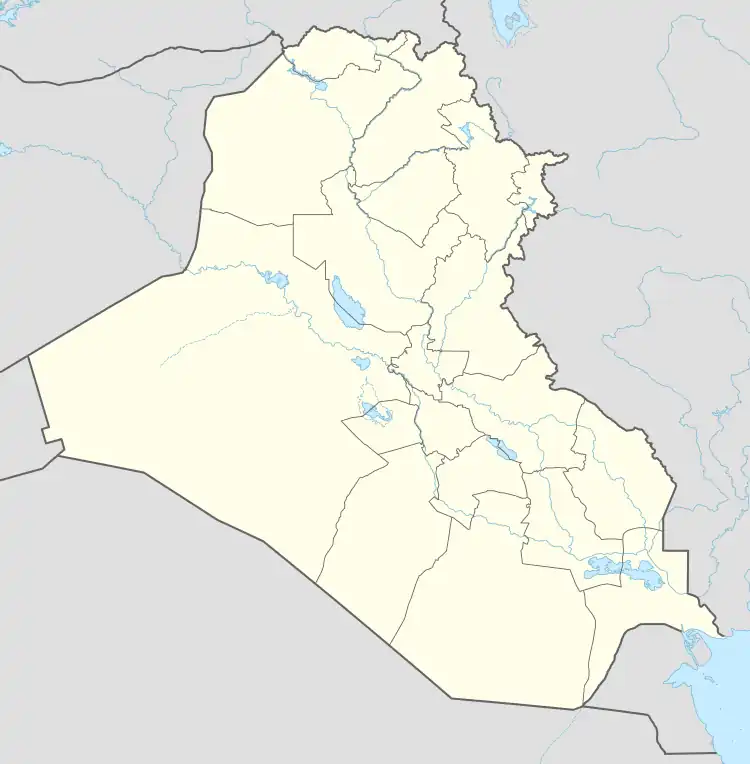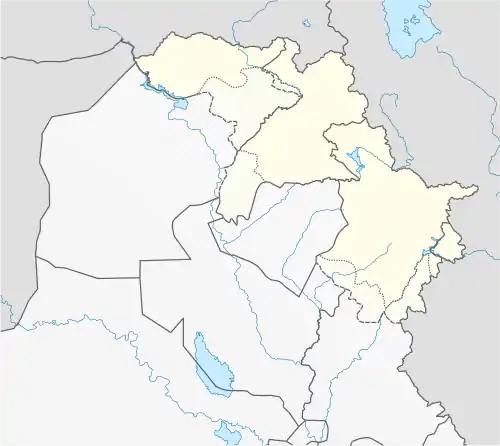Deraluk | |
|---|---|
Town | |
 | |
 Deraluk Location in Iraq  Deraluk Deraluk (Iraqi Kurdistan) | |
| Coordinates: 37°03′22″N 43°39′07″E / 37.05598°N 43.65188°E | |
| Country | |
| Region | |
| Governorate | Dohuk Governorate |
| District | Amadiya District |
| Sub-district | Deraluk |
| Population (2014)[1] | |
| • Urban | 44,448 |
| • Rural | 7,070 |
Deraluk (Arabic: ديرلوك,[2] Kurdish: دێرەلووک, romanized: Dêrelûk,[3] Syriac: Deira d-Luqa)[4] is a town and subdistrict in Dohuk Governorate in Kurdistan Region, Iraq. It is located on the Great Zab and in the district of Amadiya.
In the town, there are churches of Mar Khnana and Mar Gewargis.[5][4]
Etymology
The name of the town is derived from "deira" ("monastery/church" in Syriac) and "Luqa" ("Luke" in Syriac), and thus Deraluk translates to "monastery or church of Saint Luke".[4]
History
In 1920, Deraluk was settled by Assyrians of the Baz clan after their expulsion from the region of Hakkari in Turkey.[4] It was named after a ruined monastery of Saint Luke in the vicinity.[4] Prior to the Simele massacre in 1933, Deraluk was inhabited by 130 Assyrians, many of whom were forced to flee the violence and settled along the River Khabur in Syria.[4]
Deraluk was made a mujamma (collective town) by the Iraqi government in 1978 and settled by displaced Assyrians from Nerwa Rekan along the Iraq–Turkey border.[4] Fortry-five houses were constructed for the thirty households that came from Qārō, five households from Lower Nerwa, five households from Derigni, and five households from Wela.[4] In the following year, a church of Mar Khnana was constructed.[4]
It was used as a mujamma again in 1987–1988 during the Anfal campaign.[6] At Deraluk, Kurdistan Democratic Party guerrillas seized documents pertaining to the use of biological and chemical weapons by the Iraqi Armed Forces during the Iran-Iraq War in January 1988.[7]
On 5 December 2011, amidst the 2011 Duhok riots, alcohol shops were targeted by rioters and four were set alight and two others were ransacked.[8] In 2012, an estimated 525 Assyrians inhabited Deraluk.[9] Humanitarian aid was delivered to 72 displaced families from Mosul and the Nineveh Plains by the Assyrian Aid Society in January 2015.[10] As of 2021, 120 Assyrians with 45 families, all of whom are adherents of the Assyrian Church of the East, reside at Deraluk.[11]
Gallery
References
- ↑ Ali Sindi; Ramanathan Balakrishnan; Gerard Waite (July 2018). "Kurdistan Region of Iraq: Demographic Survey" (PDF). ReliefWeb. International Organization for Migration. Retrieved 5 September 2021.
- ↑ "العراق.. محافظ دهوك يجدد مطالبته بإنهاء وجود إرهابيي "بي كا كا"". Anadolu Agency (in Arabic). 13 April 2021. Retrieved 31 July 2021.
- ↑ "بەهۆی بۆردوومانەکەی تورکیا لە دێرەلووک چوار کەس گیانیان لەدەستداوە". Rudaw Media Network (in Kurdish). 24 January 2019. Retrieved 31 July 2021.
- 1 2 3 4 5 6 7 8 9 Donabed (2015), p. 318.
- ↑ "Mar Gewargiz church – Deraluk". Ishtar TV. 7 October 2011. Retrieved 31 July 2021.
- ↑ Donabed (2015), pp. 204, 318.
- ↑ Hiro (1991), p. 282.
- ↑ Zewki, Hikmat (5 December 2011). "More liquor stores torched in Duhok, Iraqi Kurdistan". Ekurd.net. Retrieved 31 July 2021.
- ↑ "Christian Communities in the Kurdistan Region". Iraqi Kurdistan Christianity Project. 2012. Archived from the original on 24 November 2020. Retrieved 14 August 2021.
- ↑ "AAS-Iraq Continues The Distribution Of Clothes To Displaced Families In Deraluk". Assyrian Aid Society. 3 January 2015. Retrieved 31 July 2021.
- ↑ "Population Project". Shlama Foundation. Retrieved 19 August 2021.
Bibliography
- Donabed, Sargon George (2015). Reforging a Forgotten History: Iraq and the Assyrians in the Twentieth Century. Edinburgh University Press.
- Hiro, Dilip (1991). The Longest War: The Iran-Iraq Military Conflict. Psychology Press.
